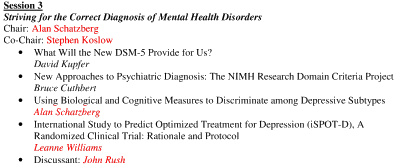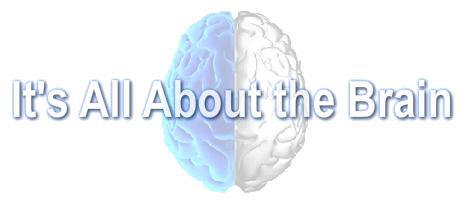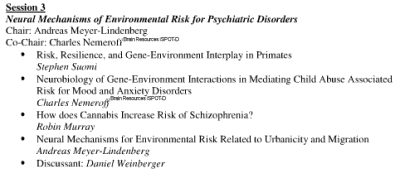I noticed that the ACNP [
American College of Neuropsychopharmacology] meeting was coming up in early December, and I was perusing the
program looking for something specific. What were the people identified by Senator Grassley’s investigation up to these days? Were they still active in ACNP? What I found was this session, and it sent me off in a different direction:
There were two of them in the same session [Alan Schatzberg and John Rush]. But they were there with two others [Stephen Koslow and Leanne Williams] who are also authors with them in the iSPOT-D study being conducted by Brain Resource, an Australian Company run by Evian Gordon:
Nicholas Cooper and Stephen Wisniewski are longtime Rush co-authors on STAR*D papers, and Charlie Nemeroff – well, you know who he is. So what was my different direction on seeing this session? It seems really odd. I suppose it makes sense for David Kupfer, head of the DSM-5 Task Force, and Bruce Cuthbert representing the NIMH RDoC [Research Domain Criteria] to be presenting in a session called Striving for the Correct Diagnosis in Mental Disorders. But what’s the gang from Brain Resource doing there? What does iSPOT-D have to do with the topic?
"The aim of iSPOT-D is to identify pretreatment measures that predict or moderate MDD treatment response or remission to escitalopram, sertraline or venlafaxine; and develop a model that incorporates multiple predictors and moderators."
It seems gratuitous, like a way to get the
iSPOT-D study on the program. Dr. Koslow was formerly Director of Neuroscience at the NIMH, and is now with Evian Gordon’s
Brain Resource Company. Dr. Gordon is a psychologist, something of a guru who has tapes and presentations all over the Internet – an
example. He seems to be a cross between "brain trainer" and a motivational speaker. I summarized what I could make of
Brain Resource earlier this year [
personalized medicine: the Brain Resource company I…,
personalized medicine: the Brain Resource company II…]. His company has jumped onto the personalized medicine idea in a big way gathering experts at his
The Mayflower Conference to discuss the topic. Having three Grassley alums on one study is pretty impressive:
One of the Clinical Sites for the
iSPOT-D study is their
Brain Resource Center in New York – something I didn’t locate back in April when I was looking into personalized medicine.
In case it doesn’t come across in the spaces between my words, I’m suspicious of every aspect of this enterprise: the motivational videos with their simplified and sometimes fantastic connections between brain and behavior, the slick web site, the cast of characters at the The Mayflower Conference, his choice of coauthors, the "assessment" and its promises – the whole gestalt is of lots of financial backing and some very fluid and loose science. This personalized medicine line of thinking in mental illness feels like a money-making scheme in training. John Rush [lately of Singapore] is the former Director of the TMAP scam and P.I. on STAR*D, the NIMH study that produced a record number of papers but no visible results, joined by two of his chronic partner authors and his trusty writing assistant slash science fiction author ["We gratefully acknowledge the editorial support of Jon Kilner, MS, MA …"]. Charlie Nemeroff has been involved in most every psychiatric money making scheme for twenty years, a surviver of multiple defrockings and expose`s. Alan Schatzberg, Nemeroff’s partner in crime on a ghost-written, industry funded textbook is the founder of Corcept, a long running company trying to capitalize on an ineffective treatment for depression. And there are three people from Brain Resource, a company that mixes and matches pop psychology, pop neuroscience, and modern media with semi-hard science in often unintelligible ways. I cringe at what they’ll come up with and anticipate expensive assessment tools for picking treatments filled with sound and fury, signifying nothing.
I wouldn’t even mention this except that they’ve gotten themselves onto the program of ACNP, just like they attracted the who’s who in neuroscience to their Mayflower Conference. And they’ve engaged David Kupfer of the questionable DSM-5 fame and Bruce Cuthbert who’s pushing the NIMH RDoC that’s going to classify mental illnesses by the data from neuroimaging, genetics, etc. It feels more like entrepreneurial neuroscience than something for the program of a scientific organization like ACNP. I wonder what they were thinking?…
Update: I guess I should mention this Session to round out the Grassley Quartet:



Here’s the pharma paid KOLs at Stanford talking to the public on the 7th Annual Mood Disorders day now available
http://bipolar.stanford.edu/video/index.html
to watch on video, I wonder if they ever disclosed to the innocent public there how much pharma income they take from the drug cos that make the psych drugs…. it should have been a lesson in Conflict of Interest!
PS Schatzberg is in one of the videos….
I wish I had more time to look at this stuff, but I can tell you for sure that there is a “pub plan” in place. That means ghost writers, messaging, planned placement of key messages, etc. Here’s a giveaway:
Compare this:
“Based on these guidelines, EEG biofeedback is considered to be “probably efficacious” for the treatment of ADHD and merits consideration as a treatment for patients who are stimulant “nonresponders.” Although research findings published to date indicate positive clinical response in approximately 75% of patients treated in controlled group studies, additional randomized, controlled trials are needed to provide a better estimate of the robustness of this treatment.
Published 26 November 2004 in Child Adolesc Psychiatr Clin N Am, 14(1): 55-82, vi.
And this:
And this:
“On the basis of these scientiï¬c principles, EEG biofeedback was determined to be “probably efï¬cacious†for the treatment of ADHD. Although significant clinical improvement was reported in approximately 75% of the patients in each of
the published research studies, additional randomized, controlled group studies are needed in order to provide a better estimate of the percentage of patients with ADHD who will demonstrate such gains in clinical practice.
Applied Psychophysiology and Biofeedback, Vol. 30, No. 2, June 2005 ( ⃠2005)
Those are 2 of the “Relevant Research” papers in the ADHD section of brain resource center. Another is an unpublished doctoral dissertation.
There is certainly more here than meets the eye. You’re onto something big here.
A little more looking: The Brain Resource Center claims that any mood disturbances or cognitive issues correlate with a specific imbalance in the brain or autonomic nervous system:
The result of the assessment process is a comprehensive report that links any mood related symptoms (depression, anxiety, mood swings, etc.) or limitations with cognitive abilities (problems with learning, memory, attention, cognitive flexibility, executive functions, etc.) to objective measurable imbalances in the brain and autonomic nervous system.
They find these “imbalances” with a system called quantitative EEG (qEEG). Brain mapping is done with a proprietary platform owned by an affiliate (Brain Resource Limited) and what is or isn’t normal is based on data from another affiliate (the Brain Resource International Database).
So they tell you any issue you you have is related to a measurable problem, based on their proprietary measurements, and that they can treat them using their proprietary techniques.
This is big money–ADHD, Alzheimers, people in whom antidepressants didn’t work (a big number). There are probably a lot of physician investors in all this.
Talbot,
Thanks for that. I got kind of lost in all those EEG flavors…
Noticeably missing from ACNP’s 50th Annual Meeting program is Madhukar Trivedi, M.D.